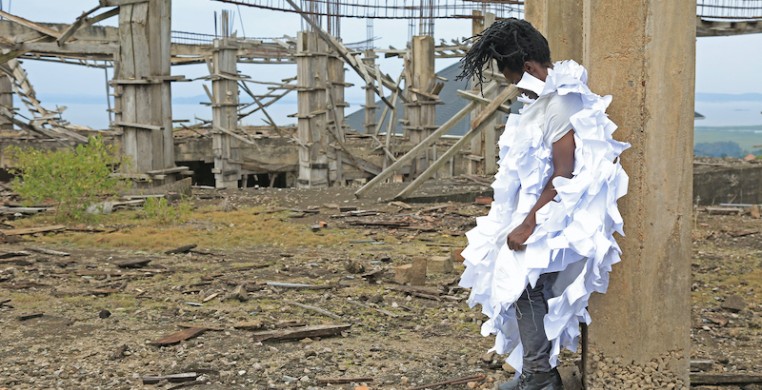What does it mean to belong? What does it mean to be resilient? What does it mean to be yourself? These are just some of the questions asked by the “African Crossings” performances during the 2021 JOMBA! Contemporary Dance Experience. Four dance films premiered Tuesday and featured work by Robert Ssempijja, Bernardo “Pak” Guiamba, Gaby Saranouffi, and Marcel Gbeffa. I was immediately drawn in by the first piece, “Alienation,” by Ssempijja and this focus continued as the very different pieces were unveiled.
In “Alienation,” Ssempijja examines his role as a citizen of Kampala, Uganda. Before the piece, he mentions walking around his city, a city that was once intensely familiar to him, and no longer recognizing his surroundings or feeling welcome, still seeing the aftereffects of colonization. The piece opens with Ssimpijja standing and sliding slowly among cement poles, perhaps remnants of some building’s structure. This sets the scene for the piece to be about place, in this case, Kampala. Ssempijja dances in two forms, next to one another, in street clothes and in a rippling white garment.
Then we are suddenly transported to a rounded interior courtyard. As Ssempijja continues to freely run and pause, run and pause, street signs appear behind him, baring names like John Speke, Major General Henry Coville, Lord Frederick Lugard, Prince Charles and Princess Anne. I’ll be the first to admit that as a citizen of the United States, even my knowledge of American history is lacking, let alone my understanding of African history and British colonization. I was frantically squinting trying to catch the names behind Ssempijja, while not losing focus on the dance, and then quickly googling the names. I scanned Wikipedia pages and other results since the only name I initially knew was Prince Charles. These names all represent the presence of England, including many explorers and military, in Africa, in this case particularly in Uganda. These people are symbols of colonialization.
Ssempijja asks at the start, “What am I?” and “Is it me? Or is it the city that has rejected me?” And who hasn’t felt like a stranger, even in the place they grew up? But I can only imagine it is different when this city has been invaded and changed over decades, and you have been made to feel like a stranger. Ssempijja closes with some answers to these questions: “I am the noise in your ear. I am the feet on the road.” He concludes, “I’m Ssempijja. I’m Kampala.” These simple statements, as dozens of artificial papers float down around him, are a powerful reclamation of identity, presence and belonging.
Of a different stroke, the piece “In My Mind,” by Marcel Gbeffa, examines what it means to be a citizen of your own headspace, in a sense. Gbeffa is shown sleeping uncomfortably in bed, moving amongst piles of children’s toys, and then dancing on mostly barren landscapes. The colors on the screen alternate between full color, washed out and red tones only. This has a very psychological effect, giving the sense that we as the audience are in Gbeffa’s mind. In between bursts of sleep, we are getting glimpses into his thoughts and emotions, through this sleep-state.
The dancing itself is quite fluid and continual. The only pauses are as the camera cuts between a location or a change in color scheme. This choice, for the movement to continue flowing within a shot, carries on the almost dream-like state for the audience as we proceed through experiencing Gbeffa’s mind. By the end of the piece, I found myself with more questions than answers. What emotions was Gbeffa trying to represent? What thoughts was he experiencing? Yet, I still got a sense of his headspace, even if not in words.
It is a common experience that movement and dance can often say more than words can. And that was true with Gbeffa’s “In My Mind.” For all the pieces of this “African Crossings” hour, I had many more questions. What are people really like? Why do we interact with one another in these ways? But I don’t expect myself to find most of the answers in written word. Even so, what language would it be in? Yes, some of the pieces incorporated text, and that added a powerful familiarity for me through people able to read or hear English. “In My Mind” though, as well as the other pieces, showed how much clearer it can be to communicate a feeling though through dance.
--
The JOMBA! Contemporary Dance Experience continues with daily shows online through Sept. 5. For more information and to access the performances, visit jomba.ukzn.ac.za.

2021 Critical Dance Writing Fellow Morgan Rondinelli is an MFA student at Western Connecticut State University, with focuses on creative nonfiction and science writing. Much of her previous writing has centered around mental health on her blog, My OCD Voice (myocdvoice.com), and as a super contributor for the health and disability publication, The Mighty. She is also the co-founder of the mental health nonprofit, Not Alone Notes (notalonenotes.org), which mails encouraging, handwritten notes around the world. In her free time, Morgan performs in shows and choreographs for Community Players Theatre in Bloomington-Normal. As a lifelong dancer, she looks forward to writing more about dance and the arts.

